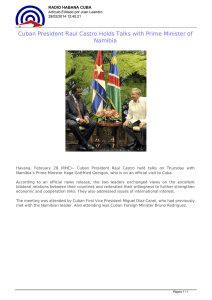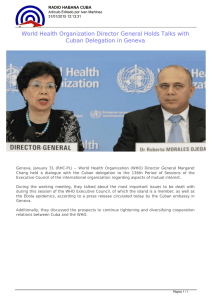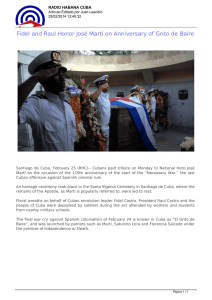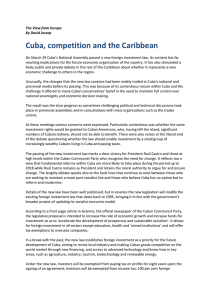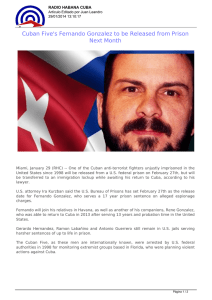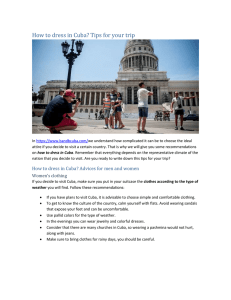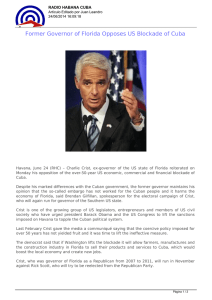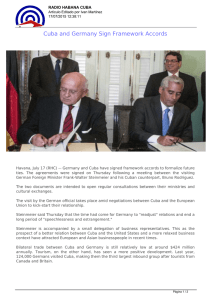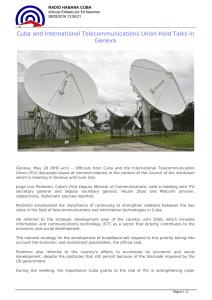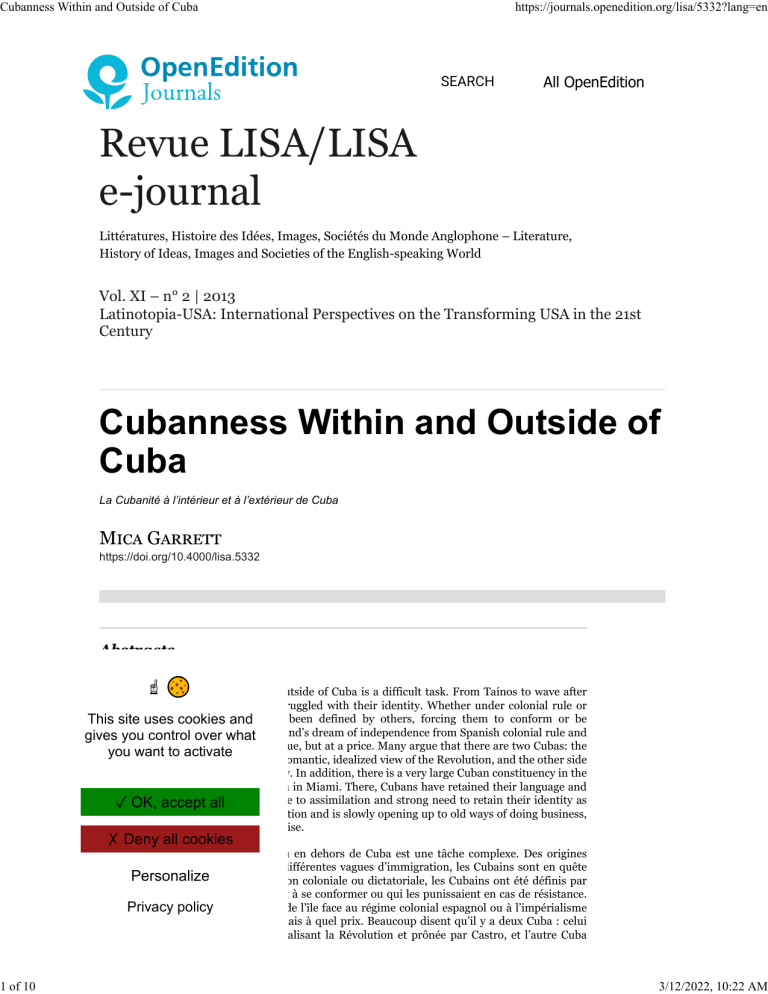
Cubanness Within and Outside of Cuba 1 of 10 https://journals.openedition.org/lisa/5332?lang=en SEARCH All OpenEdition Revue LISA/LISA e-journal Littératures, Histoire des Idées, Images, Sociétés du Monde Anglophone – Literature, History of Ideas, Images and Societies of the English-speaking World Vol. XI – n° 2 | 2013 Latinotopia-USA: International Perspectives on the Transforming USA in the 21st Century Cubanness Within and Outside of Cuba La Cubanité à l’intérieur et à l’extérieur de Cuba M��� G������ https://doi.org/10.4000/lisa.5332 Abstracts ☝� banness inside and outside of Cuba is a difficult task. From Taínos to wave after rants, Cubans have struggled with their identity. Whether under colonial rule or Cubans This site uses orship, cookies and have been defined by others, forcing them to conform or be . Under Castro, gives you control over whatthe island’s dream of independence from Spanish colonial rule and finally came true, but at a price. Many argue that there are two Cubas: the you want torialism activate would have us see, a romantic, idealized view of the Revolution, and the other side ✓ OK, and his followers deny. In addition, there is a very large Cuban constituency in the including Mini Havana in Miami. There, Cubans have retained their language and due toall their resistance to assimilation and strong need to retain their identity as accept case, Cuba is in transition and is slowly opening up to old ways of doing business, sm and private enterprise. ✗ Deny all cookies Cubanité » à Cuba ou en dehors de Cuba est une tâche complexe. Des origines des Taïnos, issus de différentes vagues d’immigration, les Cubains sont en quête Personalize ce soit sous domination coloniale ou dictatoriale, les Cubains ont été définis par qui les contraignaient à se conformer ou qui les punissaient en cas de résistance. rêve d’indépendance de l’île face au régime colonial espagnol ou à l’impérialisme Privacy policy nfin devenu réalité, mais à quel prix. Beaucoup disent qu’il y a deux Cuba : celui ision romantique, idéalisant la Révolution et prônée par Castro, et l’autre Cuba 3/12/2022, 10:22 AM Cubanness Within and Outside of Cuba 2 of 10 https://journals.openedition.org/lisa/5332?lang=en que le dictateur et ses sympathisants ne reconnaissent pas. De plus, il y a une très grande communauté cubaine aux États-Unis, notamment Mini Havana à Miami. Là, les Cubains ont gardé leur langue et leur culture, car ils ont résisté à l’assimilation dans leur besoin de préserver leur identité cubaine. Quoi qu’il en soit, Cuba est dans une phase de transition et s’ouvre doucement aux anciennes pratiques commerciales parmi lesquelles figurent le tourisme et l’entreprenariat privé. Index terms Index de mots-clés : Cuba, cubanité, identité, hybridité, Castro Fidel Index by keywords: Cuba, Cubanness, identity, hybridity, Castro Fidel Full text 1 2 The origin of the word Cuba is unclear, however, many scholars would agree that it comes from the Taíno word cubao which signifies ‘abundant land’. The Taínos, as the original inhabitants were called, were peaceful compared to their neighboring Caribs who inhabited the Lesser Antilles, nevertheless they were oppressive. They enslaved a few siboneyes, cave-dwelling inhabitants and the others were “restricted to the modern province of Pinar del Río and several offshore islands.” (McGaffey and Barnett, 33) By 1492, at the time of Spanish arrival, there were approximately 200,000 inhabitants on the island and they welcomed Columbus with food, dance, and games. While at first they embraced the Spanish, they soon found themselves being victimized. Within a short time those that resisted conversion to Christianity were enslaved and sent to work in gold mines. Harsh working conditions and disease wiped out many Taínos and led to the virtual disappearance of their society. Although very little of Taíno ethnicity remains in Cuba today, there is still evidence of it today. The Taíno people were freed in the sixteenth century and went on to form their own small reservations which remained in geographic isolation for a long period of time. By then, only a few thousand Indians remained. In the twentieth century Antonio Núñez Jiménez discovered a group of Taínos that had been living in Oriente province. Some of the Taíno contributions still in evidence are the herbal remedies, bohíos, which are dome homes built with thatched roofs and many words in the Spanish and English languages.1 Due to the demise of native laborers, the Spanish were left with a shortfall of manpower and thus brought in African slaves to work in the mines and plantation Although statistics vary, some sources say that by the mid-nineteenth mulatoes comprised almost fifty per cent of the Cuban For that reason, African influence in Cuba is significant and has contributed This site uses cookies and traditions, including religion, food, music, and language (Yoruba, Fon, and gives you control over what ). Percentages of people from African ancestry are higher in rural areas in you want to activate although Cubans have not been very racist by American standards, black e experienced racism. This is nothing new; racism in José de Martí’s time le in thatall “anti-Negro feeling among supporters of independence was one of ✓ OK, accept test difficulties.” (McAffey and Barnett, 32) As recently as the 1950s, Afroe banned from many of the high-class hotels and beaches, but still had their ✗ Deny all cookies ive clubs where they could go. Racism was also present within the African ome districts mulatto societies excluded persons considered too dark.” (ibid., ☝� Personalize he policy more important African legacies in Cuba is religion. It is noteworthy Privacy has played an important role in the development and change of Cuban identity over time. Before 1959, Cubans were mostly Catholic and a smaller 3/12/2022, 10:22 AM Cubanness Within and Outside of Cuba 3 of 10 4 https://journals.openedition.org/lisa/5332?lang=en percentage practiced santería, a mixture of African (mostly Yoruba) and Catholic religions. Shortly after the Revolution, however, Castro’s relationship with the Church became more strained. Castro accused the Church of caring more about the imperialists than following Christ’s examples of feeding the poor and righting social injustices. He claimed that the Church was out of line with his new ideological plan for Cuba. According to Castro, the Church’s “superficial” views were “simply incompatible with the dramatic revolutionary process on which the country had embarked.” (Kirk, 107) Under Castro, the practice of any religion was considered subversive and many had to practice their worship in private without attracting too much attention to themselves because, if caught, it could mean jail. For Castro, suppressing religious practices meant that Cubans could spend their time and energy worshiping the Revolution instead. As a result, many Cubans came to identify themselves more closely with political vs. religious ideology. What Castro wanted was for the people to put their faith in the State instead of God and make the nation their priority. This would help form a new public collective consciousness which previously had not been a governing practice. Whereas Taínos and Africans had been forced into a new religious belief system, post-revolutionary Cubans were forced to not practice any religion in order to give themselves fully to the new revolutionary state. Since the economic crisis in Cuba in the 1990s, religious practices have increased and have even permeated Cuban media (Hansing, l7). Not only has Cubans’ religious ideology been manipulated over centuries, but practically every aspect of their lives has been turned upside down by each power that has ruled the island, starting with the Spanish colonization, continuing with the imperialist control over the Cuban people by the Americans, and, ultimately, ending with the oppression by the Castro Revolution. As a whole, Cuban collective consciousness has been closely connected to Otherness. For over 500 years Cubans have been dominated and controlled directly or indirectly by foreigners. Throughout history, Cubans and their predecessors have experienced marginalization, suppression and oppression, whether from Spanish conquerors, American imperialism, dictatorships or finally under the rule of Fidel Castro. Although Cubans had gained their independence from Spain, the American Platt Amendment ensured that the United States would keep tight economic, military, and political control of many aspects of Cuban life. During the first period of North American regulation (1898-1928), “expansion of North American economic forms and political structures […] acted in decisive ways to shape the character of the nation.” (Ibarra, 2) The United States made tremendous efforts to achieve homogeneity on the island. American dollars and businesses contributed in o the cultural, political and economic identity of the country. As a result, a e class arose in Cuba that benefited from, enjoyed and appreciated its ties to States. In addition, Cuba became a playground for the rich and famous and This site uses and d tocookies as the Caribbean Riviera. The young Republic seemed to have it all. gives you control over what e apparent, however, during the period between 1929 and 1958 that the you want to activate was over. During this period Cuba suffered from economic contraction economic crisis, political tumult, and social unrest” (Ibarra, 2). In order to how such a large part of the middle class would want to join forces with ✓ OK, accept overturnall their government, one must take a closer look at their mentality at n the short period leading up to the Revolution, the young adult children of ✗ Deny all ddlecookies class had become disillusioned. They were divided into “professionalnd “industrial-commercial” groups (Draper, 112). Fidel Castro himself is Personalize to be one of the former, his father being a self-made man and having himself w School in Havana. This group saw no future because the job market was Privacy policy nd what good was it to get a degree if there were no jobs to be found? The p was frustrated with Cuba’s lack of industrialization and overdependence ☝� 3/12/2022, 10:22 AM Cubanness Within and Outside of Cuba 4 of 10 6 https://journals.openedition.org/lisa/5332?lang=en on foreign markets for raw material processing. In any case, a large part of the middle class put their faith in Castro to solve their problems. His message cut across classes and the poor as well as the middle class joined forces. Castro always had a soft spot for the poor and it was their plight that, in part, motivated him. He promised that poverty would be eliminated after his takeover. One of the first things he did was to help poor children or becarios, the children of the peasants and the lower classes that, from an early age, were moved to Havana, fed and housed and would become the future generation that he could count on for support. Castro’s proposal for a new Cuba was not only an economic one. It was a much larger vision whose goal was ultimately freedom, a dream that Cubans had been subconsciously holding onto for centuries. According to Antoni Kapcia, Cuban history since the late eighteenth century can justifiably be seen as the trajectory of the pursuit of a ‘dream’ – of true independence (political, economic, social, cultural, intellectual or whatever). (XIV) 7 8 The term “Sierra Madre Complex” was coined by Theodore Draper to describe how Fidel Castro was able to create unconditional support in his followers, a “revolutionary will” for which they would give themselves totally and fully to the idea of revolution without expecting any material gain. Revolutionaries committed to Castro’s call were told to adopt a moral stand rather than a materialistic one. Some would argue that it was Castro’s charm and not his political expertise and know-how that helped him gain control over Cuban will. He established a “direct, personal, almost mystical relationship with the masses that free[d] him from dependence on classes.” (Draper, 133) Accordingly, Rafael Rojas claims that the “official Cuban ideology, which historically has lacked a theoretical vocation, has to do some symbolic juggling to legitimize a totalitarian order in the midst of the twenty-first century.” (59) The idea of freedom and self-government was a powerful concept and desire long held by the Cuban collective consciousness. In order to gain support, Castro had created an ‘us-against-them’ mentality and promised that the destruction of American imperialist capitalism would pave the way to a successful socialist government. As Del Aguila notes: Appealing to nationalism [meant] calling for sacrifices in order to defeat internal or external enemies, [and] invoking memories of previous struggles in heroic and mythical terms, and tapping the moral, physical, and intellectual reserves of the nation. (69) ☝� patria, is of utmost importance in Cuba, a very macho the stereotypical sense of the word. According to Ruth Behar, Cuban andcookies nationhood This site uses and were fused and confused in the figure of the revolutionary gives you control over what you wanttítoisactivate one of the more important national heroes in Cuba. He was a martyr, a ry hero, and he suffered persecution due to his political beliefs. There are monuments in his honor that are nicely maintained and are occasionally ✓ OK, accept re Fidel all Castro chose to give speeches and to hold political ceremonies. Martí, was born in Cuba of Spanish parents and studied law; they shared the ✗ Deny all cookies f helping the poor, and both fought to gain independence for Cuba: Martí Spanish colonizers and Castro from the Fulgencio Batista American . Some argue that Castro and Martí are kindred spirits and have been Personalize al in achieving Cuban liberation, while others would say that Martí would Privacy policy e of Castro and what he has accomplished. In any case, as always, public l argue one way or another based on personal views, which Cubans will likely 3/12/2022, 10:22 AM Cubanness Within and Outside of Cuba 5 of 10 11 12 https://journals.openedition.org/lisa/5332?lang=en have no problem sharing. Anti-American sentiment was also used by Castro to unite Cubans in that without America in their lives, there could be no tyranny and subjugation. According to Russell H. Fitzgibbon, there was a sense of psychological inferiority felt by Cubans that played a more than significant role in an anti-U.S. attitude: “It has colored practically all and distorted many of the Cuban reactions to matters of mutual concern to Cuba and the United States.” (254) With Fidel at the helm, Cubans would be free to create their own independent nation; one that Castro promised would bring wealth to everyone. Cubans trusted Castro and quickly rallied around his romantic vision. Excitement grew as Cubans felt for the first time that there was a real chance of fundamental change. At first, Castro’s promise of public ownership as in a true socialist society, instead of the land being owned by the few and not the many, would be the answer to the problem of capitalism, which had created a large-scale poverty, and to all of the other problems and challenges Cubans were facing. As time passed, it was soon obvious that socialism was no panacea. Problems with the United States’ embargo, as well as internal conflicts and pressures, meant that it was necessary for the State to take control of the economy. Without workers’ control there would be no socialism. Castro then looked to Russia’s 1961 model and the official Communist party was created in 1965. Cuba itself became a visual platform for Communist ideology: hammer and sickle images appeared everywhere, as well as portraits and statues of Lenin, Stalin, and local independence hero José Martí. Revolutionary imagery appeared and has remained everywhere in Cuba. In this way, Cubans came to identify more closely with the Revolution through its reflection in the Cuban landscape. In Arjun Appadurai’s terms, Cuba became an “ideoscape” which contains images that are “often directly political or ideological in that they represent the power of the state.” (Staring et al., 12) “Three Faces of Cuba,” a post-Revolution documentary released in 1962, shows how Cubans were not only bombarded with visual ideological elements, but with audio input as well, in the form of song, music, and chanting anti-American slogans. These political refrains sung by Cubans cut across all age groups. One of the examples is that of children singing “Fidel, Fidel, campeón, te comiste el tiburón, en las playas de Girón,” [in reference to the Bay of Pigs] (Hunter et al., 85) and also “Lo dicen en Manila y en Corea, en Panamá, en Turquía y en Japón, el clamor es lo mismo en todas partes: Yanqui go home.” (ibid., 81). Literature and propaganda played a crucial role in the process of reinventing Cuba as a socialist nation. According to Salván this has ributed to the intellectual formation of artists and writers and to the uction of an extensive body of laudatory literature. Many writers who orted the revolutionary project continue to do so in spite of the ent economicand and political circumstances. (6) This site uses cookies ☝� gives you control over what and women saw themselves joining organizations devoted to the you want en to activate ✓ OK, Militias and watchdog organizations, such as the CDRs (Committees for the the Revolution), were formed and any Cuban who speaks poorly of Castro or of theall government will be punished. Many prisons and behavioral accept n sites have been set up across the island in order to handle the large ✗ Deny all cookies rly years, woman’s role in the Revolution was very empowering. Like other ionary loyalists, she was identified with a struggle that meant not only Personalize crifice, but also conflict on a grand scale, giving her a large sense of Privacywithin policythe social construct of the new system. Historically, women had ed equality with men within the home, as reflected in the 1940 constitution. arra illustrates, “Cuban legislation on women’s rights (divorce, maternity, 3/12/2022, 10:22 AM Cubanness Within and Outside of Cuba 6 of 10 15 https://journals.openedition.org/lisa/5332?lang=en and equal civil rights) was among the most advanced in the Western world.” (138) After Fidel Castro came to power, Vilma Espín, a revolutionary and veteran who fought alongside him in the Sierra Maestra Mountains, organized the Federation of Cuban Women and the state provided “all women with free education, health care, birth control, access to abortion, nutritional support for pregnant mothers and young children, day care, the freedom to divorce […].” (Behar, x) The family unit suffered, however, owing to a high divorce rate and less births due to free access to abortion. Furthermore, women’s role within the family was replaced by a role on a grander scale. In the late seventies, families became even more divided when “the only way to instill new values, to create the new man and woman, was to distance children from parents, grandmothers, uncles, and other retrograde influences.” (Smith and Padula, 146) The nation intended on replacing the traditional family with “a socialist family united not by blood, but by affection, friendship, and convenience.” (ibid., 145) When the plan for socialism failed and Cuba set its sights on communism, many on the island became disillusioned, but even so have remained faithful to Castro, even to this day. Their life-long dream has become more dream-like (‘dream’ as illusion), as an imagined and even illusory reality, projected on to a possibly unattainable future and stored in a collective folk memory, but that has always remained as a shared vision (‘dream’ as envisaged future), to inspire, guide and protect. (Kapcia, xiv) 16 For fidelistas, any limitations or impediments to achieving Castro’s goals might be blamed on the U.S. embargo. Whether it is putting the blame on the Americans or the collapse of the Soviet Union, Cubans can always find a scapegoat. In this way, they can talk about the triumph of the Revolution and at the same time experience the great stress that Cuban society endured during the Special Period of the early nineties: The shortages and the black market, the de facto unemployment, the deterioration of social services, the rationing [; … t]he complaints about food shortages, poor quality, and lack of variety are becoming fears about real hunger. (Judson, 28) 17 Twenty years later, things have not changed much for most Cubans. According to a New York Times article in 2011, enders, with access to dollars, earn wages many times that of ☝ icians � […] Many roads in Havana have been repaired. Microwave s, DVD players This site uses cookies and and cellphones are now in stores, but most Cubans ot afford them. gives you control over what(Urbina) you want to activate ve always been two Cubas: the mainstream and the marginalized, the d imperial dominating forces against the oppressed. At present, again, Cuba urrently there are those that identify with the success of the Revolution and ✓ OK, accept all ee themselves as victims of it. Some would argue that there is the Cuba that to present to the world and the other that he likes to hide. For example, ✗ Deny all cookies edicine has been one of Cuba’s success stories, as narrated by those who nd documentaries, such as Michael Moore’s Sicko, have presented a good Personalize ba’s healthcare system. According to others, however, it is a good story but . In ABC's episodes of 20/20, aired on September 7th 2007, John Stossel Privacy policy Michael Moore about his documentary and its positive portrayal of Cuban Stossel showed pictures and video clips of the hospitals that were in ghastly 3/12/2022, 10:22 AM Cubanness Within and Outside of Cuba 7 of 10 19 https://journals.openedition.org/lisa/5332?lang=en shape and explained that these were the facilities that most Cubans used. Stossel pointed out that the hospitals which Moore visited were the facilities used only by foreigners and privileged Cubans who could afford them. In the same film by Stossel, Dr. José Carro, a human rights activist from Miami confirmed that Moore's claims were lies and that there were two categories of hospitals in Cuba, some for the elite and others for the general population. The Hannity and Colmes show that aired on October 10th 2007 on Fox News showed additional pictures so damaging, (crumbling walls, insect infestations, and no soap or towels, to name just a few of the problems), that ABC had refused to air them on Stossel’s show. Another example of the side of Cuba that revolucionarios like to boast about is education. Literacy has shot up to over 90 % but, whereas normally this would be good, others would argue that education is just another tool used to control the people, and that censorship is so severe that Cubans are not allowed to study or read anything at all that is not pro Castro. In addition, they would claim that education is a dead end because there are not enough jobs to go around once you graduate from school. Since the collapse of Russia and most of the Communist states, Cubans have plunged into an economic crisis that has had a profound impact on their character and resilience. According to Katrine Hansing, apathy, depression, and migration are some of the more dramatic consequences of this, [however,] many if not most Cubans have been responding by carving out their own spaces, whether economic, social, or cultural, that are independent or at least parallel to the state. (l6) 20 Many Cubans are deeply divided on the subject of the Revolution and many families have been torn apart physically and emotionally because of it. Some speak of el triunfo de la Revolución and others of el fracaso. You are either “for it or against it” and there is nothing in-between. Cuba has become a “social movement” framework as defined by social anthropologist Ulf Hannerz2 wherein lie “ideological battles between ‘converted’ and ‘non-converted.’” (Staring et al., 12) The success or failure of the Revolution is a matter of perspective and there are clearly two sides to the story. Many Cubans have been discouraged; this was especially true with the collapse of the Soviet Union whereupon Cuba experienced a Special Period of severe economic crisis. Stratification within Cuban society became clear: […] the apartheid quality of the relationship between tourist and Cuban n [is one of the most] grinding and demoralizing aspects of daily life. Perhaps more serious in the long-term political sense are the degrees nicism, the dissolution of social solidarity, the justified concern about This site uses and nt cookies crime, delinquency, and alienation. (Judson, 28) ☝� gives you control over what you want Revolution to activate have come many sacrifices, not only for those that side with also for those that oppose him. Tens of thousands of Cubans have died cape the Revolution. Others have successfully escaped through emigration. ✓ OK, first accept allof migration coincided with the early years of the Revolution and waves ostly the middle- and upper middle-class professionals who understood that ✗ Deny all oingcookies to lose everything by staying. Many who migrated in 1959 have waited, prayed for the day when they could return to their homeland. They have ate of limbo and, unfortunately now, many have either died or given up the Personalize urning to the island. For those opposing the Revolution, both within and Privacy policy Cuba, Castro’s dream represents what identity theory critic Patrick Taylor hic narrative”, a communication in “falsely universal terms” (Matibag, 208). 3/12/2022, 10:22 AM Cubanness Within and Outside of Cuba 8 of 10 22 https://journals.openedition.org/lisa/5332?lang=en It is a narrative in opposition to reality and based on a story used to explain how a society might perform best for everyone. The United States, a long-time “melting pot”, has been the recipient of wave after wave of Cuban immigration. Sometimes living in groups and sometimes in isolation, they have become a part of the “local human landscape” in the ever-changing global ethnoscape, which is, according to Appadurai’s definition, [a] landscape of group identity, the landscape of persons who make up the shifting world in which we live: tourists, immigrants, refugees, exiles, guestworkers, and other moving groups and persons who can affect the politics of and between nations. (qtd. in Staring, 12). 23 24 Many Cubans who live in Miami consider themselves to be Miamians. Miami houses most of the Cuban and Cuban Americans that live in the United States, around 700,000 of the one million that live stateside. These Cubans, like many other immigrants have made an enclave which helps to promote and preserve their culture. The first wave of Cuban migration into Miami happened in the early years after Castro’s takeover. This Cuban community allows for the preservation of much of the Cuban culture with which they have come to identify. There they can promote their food and other material items that remind them of home. Many are very conservative Republicans who would like to see the island return to the way it was: one that they either had experienced as young children, or pictured in their minds by way of their parents and grandparents who had lived there. According to Callejo-Pérez, after the Revolution, the older generations’ retelling of the Cuban story led the young to believe that “Cuba was no longer Cuban,” and “fostered a love of place for the young 20-year-olds who sought a connection to the island and its culture.” (7) These Cubans did not fight assimilation; instead they injected Cuban identity and culture into it. In fact, the Cuban diaspora has assimilated to varying degrees into the dominant culture. For some Cubans, visibility and identification is much more noticeable than for others, especially for first generation Cubans who have not lost their accents and other daily habits. If Cuban identity is determined by everything cultural, then they must choose what part of their language, food, and other items they will keep with them and what they want to leave behind. These Cubans will always be hybrid. Many Cubans outside of Cuba have had to struggle with the sense of homeland. Some second- and third- generation Cuban Americans have felt a sense of identity crisis or inbetweenness, especially as the distance between them and their Cuban roots has ater. For some of these children of Cuban immigrants and their children, the becomes a painful process that Romero describes as a transformation which oices about what to keep and what to forget, keeping enough in order not to This site uses cookies and own identity while opening up to new experiences and a new culture.” ☝� gives you control over what you want to activate y on angst as a theoretical approach to identity, Callejo-Pérez claims that ttempts are made to bridge the separation, the question of defining Cuban pervasiveallissue.” (2l5) Sometimes Cubanness can be defined in terms of ✓ OK, accept of immigration one belongs to, or as Rothe and Pumariega put it, like the andcookies shutting off of a water faucet, depending on the political climate or ✗ Deny all ions” between the United States and Cuba. Those that left the island early after the Revolution have assimilated the most into American culture. Their Personalize allowed them strength in numbers as well as upward mobility. They also ‘white’. The next big wave of immigration was from the Mariel Boatlift Privacyore policy t brought the working class who were disillusioned with the Revolution and ical unwanted. An estimated 71% of the 124,000 that left were blue-collar 3/12/2022, 10:22 AM Cubanness Within and Outside of Cuba 9 of 10 26 https://journals.openedition.org/lisa/5332?lang=en workers. After the collapse of the USSR and the end of its support for Cuba, many left on makeshift rafts in order to escape the economic crisis. Known as balseros, these were mainly the poor, black or mulatto that the Revolution had tried to help. It is estimated that 37,000 Cubans left the island in this way. Since then, Cuba and the United States have negotiated a quota allowing 20,000 Cubans to immigrate each year (Rothe and Pumariega). What is Cubanness? What is it to be Cuban? Oftentimes it is not a choice. Cubans have always been victims in that they have never had the opportunity to choose for themselves. Since the Spanish colonization/invasion, Cubans have been forced to conform to one way of life or another. First, Cubans were forced into Christianity: early Cuban religious identity was chosen for them and not by them. Second, they were forced into slavery meaning that freedom was taken from them. In both cases they were not free to choose their own way of life. After the Spanish experience came American manipulation management and Cubans were forced to become Westernized. Lastly, Cuban life has been influenced, directed, and molded by Castro and his ideologies. Enduring slavery, Americanization, and Castroism has not been so much a choice but rather a necessity to survive and/or become part of mainstream Cuban society. In Cuba, in essence, Cubanness could be defined as submission and conformity. While in Cuba, Cubans have not been given a chance to express themselves freely or been allowed to invent their own identity. Outside of Cuba, Cubanness has meant a form of assimilation and hybridity. Either way, they have been forced once again to adopt characteristics of the dominant culture. Cubanness, simply stated, is Otherness. Bibliography APPARUDAI Arjun, Modernity at Large, Minneapolis: U of Minnesota P, l996. BEHAR Ruth, “Foreword,” in Cubana: Contemporary Fiction by Cuban Women, Boston: Beacon P, 1998. DOI : 10.1016/0020-7292(92)90020-J CALLEJO-PÉREZ David, “Enacted Curriculum and the Search for Identity: Angst and the Cuban Search for Meaning after the Cuban Revolution,” Curriculum & Teaching Dialogue 10.1-2, 2008: 213-231. DEL AGUILA Juan M, Cuba, Dilemmas of a Revolution, Boulder (CO): Westview P, 1994. DRAPER Theodore, Castroism: Theory and Practice, New York: Praeger, 1965. FITZGIBBON Russell H., Cuba and the United States: 1900-1935, New York: Russell & Russell, ☝� rine, “Changes From Below: New Dynamics, Spaces, and Attitudes in Cuban A Report on the Americas 44.4, 2011: 16-42. This site uses 10714839.2011.11722145 cookies and gives you control ard,over Karl what BAARSLAG and Oliver CARLSON, An Expose of you want to activate Miami: The Truth About Cuba Committee, Inc., 1965. the Insidious Film Prologue to Revolution: Cuba, 1898-1958, Colorado: Lynne Rienner Publishers, ✓ OK, accept “Cuba all and the New World Order,” Monthly Review, 1992. /MR-044-07-1992-11_3 ✗ Deny all cookies Cuba: Island of Dreams, Oxford: Berg, 2000. Between God and the Party: Religion and Politics in Revolutionary Cuba, Personalize Afro-Cuban Religious Experience: Cultural Reflections in Narrative, Privacy policy BARNETT, Twentieth Century Cuba: The Background to the , New York: Doubleday Anchor, 1965. 3/12/2022, 10:22 AM Cubanness Within and Outside of Cuba 10 of 10 https://journals.openedition.org/lisa/5332?lang=en ROJAS Rafel, “The Content of Socialism in Cuba Today,” Interventions: The International Journal of Postcolonial Studies 12.1, 2010: 57-63. DOI : 10.1080/13698010903553286 ROMERO Héctor R., “Hispanic Literatures in the United States: Differences and Similarities,” in Proceedings from the National Association of African American Studies and Literature Monograph Series, Houston: February 21-26, 2000, 1-18. ROTHE Eugenio M. and Andrés J. PUMARIEGA, “The New Face of Cubans in the United States: Cultural Process and Generational Change in an Exile Community,” Journal of Immigrant & Refugee Studies 6.2, 2008: 247-266. DOI : 10.1080/15362940802198934 SALVÁN Marta Hernández, “Out of History: The Cuban Postrevolution,” Revista Hispánica Moderna 64.1, 2011: 81-96. SMITH Lois M. and Alfred PADULA, Sex and Revolution: Women in Socialist Cuba, New York: Oxford UP, 1996. STARING Richard, Marco VAN DER LAND, Herman TAK and Don KALB, “Localizing Cultural Identity,” Focaal 30/31, 1997: 7-21. URBINA Ian, “In Cuba, Change Means More of the Same, With Control at the Top,” New York Times, 5 Apr. 2009, sec. Americas: A6. Notes 1 Some examples of words that can be traced to their Taíno roots are huracán, hamaca, canoa, barbacoa, tatuaje and tuna. 2 Ulf Hannerz is a leading specialist in urban anthropology and local, transnational, and cultural processes as well as globalization. References Electronic reference Mica Garrett, “Cubanness Within and Outside of Cuba”, Revue LISA/LISA e-journal [Online], Vol. XI – n° 2 | 2013, Online since 30 June 2013, connection on 12 March 2022. URL: http://journals.openedition.org/lisa/5332; DOI: https://doi.org/10.4000/lisa.5332 About the author Mica Garrett niversity (USA). Mica Garrett received her Ph.D. from the University of Nebraska. She has published articles on Juan de Mena and Spanish Golden Age poets Vega, Fernando de Herrera, and Luis de Góngora. She has also published an n exile Chely Lima’s novel Confesiones nocturnas. In addition, Dr. Garrett coThis site uses cookies t revisionary and book He Said, She Says: An RSVP to the Male Text (Fairleigh s, 2001). Garrett has been teaching at Murray State University in Kentucky gives you control overDr. what ☝� you want to activate ✓ OK, accept all ✗ Deny all cookies Revue LISA / LISA e-journal sont mis à disposition selon les termes de la e Commons Attribution - Pas d'Utilisation Commerciale - Pas de Modification 4.0 Personalize Privacy policy 3/12/2022, 10:22 AM
